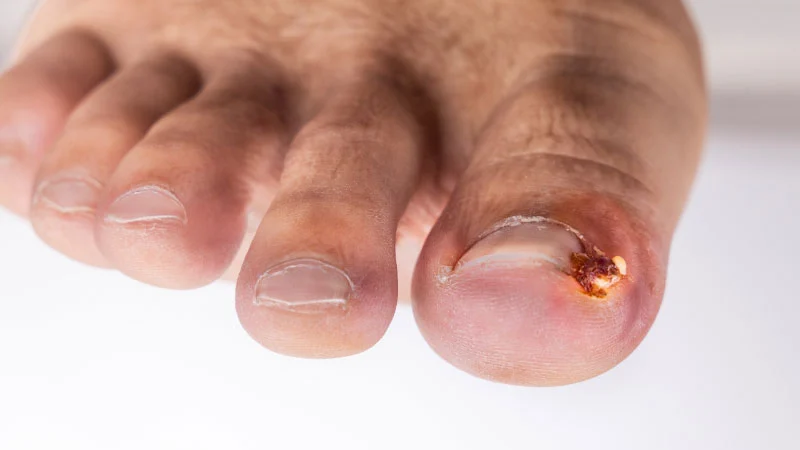Before discussing the treatment of ingrown toenails, which can be particularly effective on the toenails and cause pain, it’s beneficial to review the reasons. Let’s underline that the imbalance between the size of the nail and its extension into the nail bed is one of the most common reasons for this issue.

Sometimes, as the nail grows, it may overflow from the nail bed, damaging the soft tissue. This situation can occur due to various reasons. We can briefly list the causes of ingrown toenails as follows:
- Imbalance between the nail bed and nail size
- Wearing too tight socks or shoes that are not suitable for the foot
- Cutting the nails much shorter than necessary
- Cutting the nails in a curved shape
- Various injuries to the toenail
- The formation of curves in the toenails due to various reasons
- Incorrectly performed manicure and pedicure procedures
- A structural problem as the nails curve inward
- Traumas related to nail growth
- Fungal infection in the nail
- Excessive weight
- Being in pregnancy and postpartum period
These are the most common causes of ingrown toenails. Besides, it’s possible to say that this problem can develop due to pressure-specific reasons.
What Are the Symptoms of Ingrown Toenails?
Often, patients want to know about the symptoms of ingrown toenails. Generally, no symptoms are expected to appear. However, the development of ingrown toenails also leads to complaints of pain in patients.
Sometimes the pain occurs only when stepping on the ground, while at other times it can be constant. In this case, even if patients do not notice a visible problem when they look at their nails, they need medical help to alleviate the pain. Indeed, pain caused by an ingrown toenail is quite typical.
The pain complaint can be on just one side of the nail or both sides. Pain can occur only when touching the nail or soft tissue. The symptoms experienced in the case of an ingrown toenail can be listed as follows:
- Sensitivity in the nail bed
- Redness around the nail
- Swellings around the nail
- Increase in temperature in the tissue around the nail
- Discharge in the area where the ingrown toenail is present if there is an infection
If there is a serious pain complaint in the finger or bad-smelling discharge occurs, the patient must take this situation seriously.
What Helps with Ingrown Toenails?
Those who complain about this issue often search online for what helps with ingrown toenails. A few suggestions can be made, but you must remember to seek medical help for treatment.
Soapy Hot Water
Soaking the foot in a hot water bath is one answer to what helps with ingrown toenails. Prepare soapy hot water and soak your foot in it.
This method, which can reduce swelling and somewhat alleviate pain, can be applied 2 or 3 times a day. You should keep your foot in hot water for about 20 to 30 minutes. Try to prefer olive oil-based soaps as much as possible.
Apple Cider Vinegar
Using apple cider vinegar is another method that helps with ingrown toenails. It is known for its antiseptic properties. You can add a cup of apple cider vinegar to about a bucket of lukewarm water.
Then, soak your feet for at least 20 minutes. However, after foot bath procedures, make sure to dry your feet thoroughly. It’s also beneficial to avoid keeping your feet in water for too long.
Using Ingrown Toenail Protectors
Products that provide a cushioning barrier for ingrown toenails can be used. These protectors fit around the affected area of the nail, completely wrapping the finger and acting as a sheath. These products are readily available on the market.
They are usually sold with a medicated gel that helps soften the nails and accelerate healing. However, it’s important to note that incorrect use of these products can exacerbate the existing problem. Therefore, soaking the feet in lukewarm water and easing the pain or swelling may be a safer method.
When Is Surgery Needed for Ingrown Toenails?
Not every patient with an ingrown toenail issue necessarily needs immediate surgery. However, in some cases, surgery might be the answer to how to get rid of an ingrown toenail. Therefore, it’s possible to say that surgery could be the only solution to achieve healing in the patient. The conditions under which the decision for ingrown toenail treatment surgery is made can be listed in a short list:
- If other treatment methods have not produced successful results
- If the patient constantly has ingrown toenail problems due to an issue in the nail roots or nail structure
- If there’s a high risk of complications due to diseases such as diabetes
Surgery can be considered necessary in any of these three conditions. However, it’s important to note that the surgery is completed quickly, and the recovery

